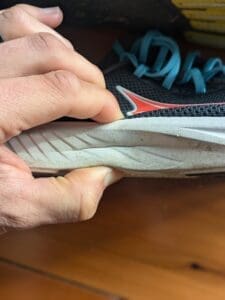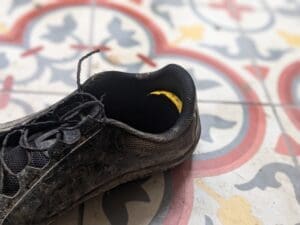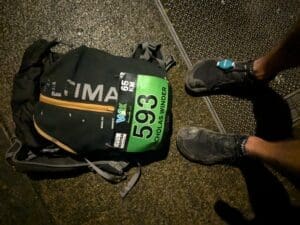What shoes are you considering throwing on for your next run? Are they the same old pair you always wear?
What if I told you that your favorite pair of shoes could limit your potential and increase your injury risk? I’m not trying to scare you, but there is an easy solution.
Shoe rotation.
In essence, it’s simple: Don’t wear the same pair of shoes for every run. But that doesn’t tell the whole story, especially when it comes to barefoot shoes.
Side note: I don’t believe shoe rotation is strictly necessary, especially if your budget is tight. But considering a shoe is a tool that can manipulate your running gait, it’s a good idea to question whether the patterns developed due to that shoe are good.
I rotate between minimal/barefoot shoes and cushioned, foot-shaped options in my daily running. I will admit I am predominantly in minimal shoes, but I don’t shy away from the likes of Altra.
These two categories of shoes are simply tools to achieve different outcomes.
I love to feel the ground beneath my feet when wearing minimal shoes. The increased proprioception—the body’s ability to sense its position, movement, and balance without visual cues— allows me to adjust quickly on the trail and provides feedback to my brain to make minute movements to enhance my balance.
Cushioned shoes, on the other hand, are a tool that fills in the gaps when I’m tired or looking for speed. I don’t reach for them due to the feel; I reach for them to shift the load away from my feet and ankles if I’m fatigued. I also throw them on when I want to run faster in a race situation (here’s the proof).
This rotation ensures that I’m not overloading any one area of my body too much, which is key for staying injury-free over the long term.
One noticeable variation in my running routine is stack height, or the amount of material between your foot and the ground.
Different stack heights affect your running gait.
Imagine trying to run on stilts. Your legs and body would balance very differently than if you were barefoot on the ground. These differences change muscle activation and your entire gait. Essentially, that’s what’s happening on a more subtle scale when we talk about stack height differences.
Which minimal running shoe is for you?
Take a quick 5-question quiz to identify the perfect minimal running shoe for your feet! You'll get both road and trail options based on your answers!
Cushioned shoes generally encourage longer strides, while barefoot shoes promote a shorter stride due to proprioception. Those longer strides are great for speed, but it also means you put higher loads through your legs (yes, you land heavier in cushioned shoes)
These changes in gait provide a different stimulus to the body, working muscles in slightly different ways that can lead to a more resilient body over time.
Whereas I’m not 100% convinced with maximal shoes because we have to draw the line somewhere (more on that later), I’m still comfortable with rotating in stack heights in the 20mm range.
Don’t just take my word for it.
A 2015 study analyzing shoe rotation showed that runners who utilized shoe rotation during their training were 39% less likely to get injured than those who did not.
As explained before, different shoes alter gait and muscle recruitment, reducing repetitive stress on any one part of the body.
While I believe minimal running shoes provide a great performance stimulus, I don’t want you to overlook cushioned options, as they are likely a good injury prevention tool.
Why? Because cushioned shoes may load your knees and hips more, whereas minimal shoes tend to load your feet and ankles more. This shift in load can help reduce the risk of overuse injuries, like calf strains or foot pain, which can occur when using minimal shoes daily.
The same argument could be made if runners ran in cushioned shoes all the time. More stress would be placed on the knees and hips, potentially causing more injuries.
Now, why not throw in conventional shoes like Nike or Hoka?
Adding your favorite Nike Vaporfly could bring more benefits if the variation is better, right?!
Not quite. We’re striking a balance between risk vs. reward.
The risk involved with using conventional shoes is much higher than the reward that specific shoe rotation could bring. If you’re unaware of the potential risks of conventional shoes like Nike, Hoka, Salamon, etc., read my blog post about pointy-toe boxes and structured shoes.
That’s not to say the occasional use of conventional shoes will ruin your body. If you want to race in them, then go for it! However, chronic use during training and day-to-day activities could lead to issues in the future.
If you’re new to shoe rotation, it’s crucial to start slow and be mindful of your body’s response.
Like anything in training, any adjustments should be made slowly, and shoe rotation is no different.
For those used to cushioned shoes, start by incorporating minimal shoes for short segments of your run—maybe just 5-10 minutes at first—before gradually increasing your time until you reach a full training session in them. Your body could take months to adapt!
The same approach applies when transitioning from minimal shoes to more cushioned options.
The key is to be mindful of your body’s response. Transitioning too quickly can lead to soreness or injury, so make sure you give your muscles and joints time to adapt to the changes in load.
Shoe rotation isn’t just about improving your performance; it’s about keeping your body healthy in the long run.
Switching between different shoes provides your body the variety it needs to adapt and grow stronger while reducing the likelihood of injury.
So before you head out the door on your next run, question which shoes you should be wearing that day. A little variation could help in the long run!
Here are some brands that I include in my rotation.
- Xero Shoes – Great for a variety of barefoot styles
- Vivobarefoot – My go-to protective barefoot trail option
- Altra – The only cushioned option that I trust
- Freet – Super deep and wide with an amazing range of barefoot performance options



